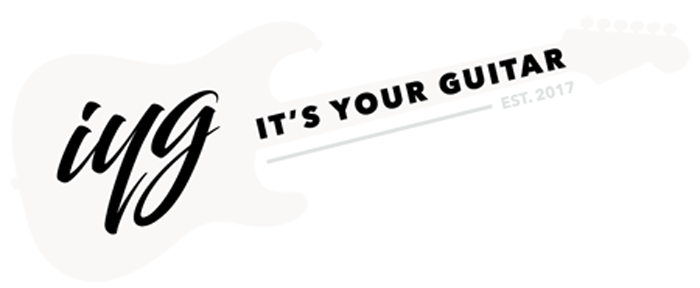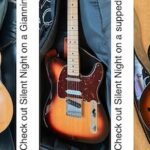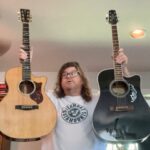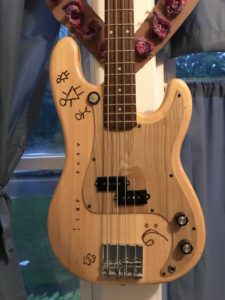
Life Bass, July 2017 —The ash pickguard is the latest upgrade.
My P-bass—The Lifebass—features drawings and symbols that represent important things to me. The mother and children represents my family, the tiny letters a QWERTY keyboard, the puzzle piece for autism awareness and the bass clef…forever. There’s also a metal pin — Honorable Mention from the National Library Of Poetry! Bridge is BadAss II. Pickups are Seymour Duncan Antiquity. The volume tone and input wiring harness was pulled from an actual 1970s’ Fender Precision bass.
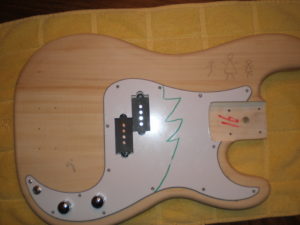
Outline — You can see my rough outline for the pickguard and where the “life symbols” would be placed.

Bridge Screws – you can see my problem here; once I tightened up the screws to get the intonation right they hang over so long they’re close to the strings (and, if I slot the bridge saddles so the string are positioned properly over the pickup poles, the strings will be touching the screws. I need to hacksaw them off (without marring the bridge/bass surface) or maybe I can lop them with my tin snips.

In the white 1 – my uncle Jack (RIP) used to make violins (fiddles, since he was a bluegrass player) and he once told me that builders would often play them “in the white” – they’d put the instrument together unfinished just to see how everything looked and played and sounded before disassembling it and finishing the parts. This principle doesn’t at all apply to building a Saga p-bass but I applied it anyway.

The Life Bass, unfinished but playable.

Finished headstock – It’s semi-glossy and has my signature on it. Sure to be a coveted family heirloom. Not pictured: the year “2008” burnt on the tip of the headstock, and some blade burns on the underside of the headstock that I couldn’t sand out.

Here is the (mostly) completed bass, all tung oil shiny. Tung oil users say you have to add a new coat or two each year to keep it shiny – maintenance boge. The oil does bring out the grain of the wood nicely – as well as highlight the gluelines holding the hunks of basswood together.The trio on the upper horn is the wife and kids, or a general representation of a primordial family. Like the ancient cave drawings you were telling me about, I don’t visually represent myself as part of the group. Maybe I should change that.
The letters are the home position on a QWERTY keyboard, the place your fingers start when you’re going to write something, the launching pad for all written thought (at least written thought done by five-fingered typists on QWERTY keyboards). The letters (and semi-colon/colon) are in the exact font, size and dimensions of an actual keyboard (or as close as I could get to exact – I traced the letters on rice paper from an actual keyboard and transferred it to the bass.) The letters look upside down but they’re rightside up to me when I’m playing or holding the bass.
The puzzle piece is the symbol for autism awareness, but it’s also a generally apt symbol for life’s many mysteries. I was torn about where to put the puzzle piece – I had a bigger one outlined on the lower horn but it didn’t look quite right. This one looks okay, but I’m having some additional puzzle piece thoughts; If I swap this pickguard for a full-sized black one, I might cut the new pickguard in the shape of a puzzle piece or keep the pickguard whole, and cut a puzzle piece keyhole shape out of the pickguard so you can see the wood beneath. Puzzle piece projects for the future.
The bass clef is giant, but I like the burn on it – it has a weathered, old-world look, like something you’d see craved on the side of a Viking ship.
-30-
